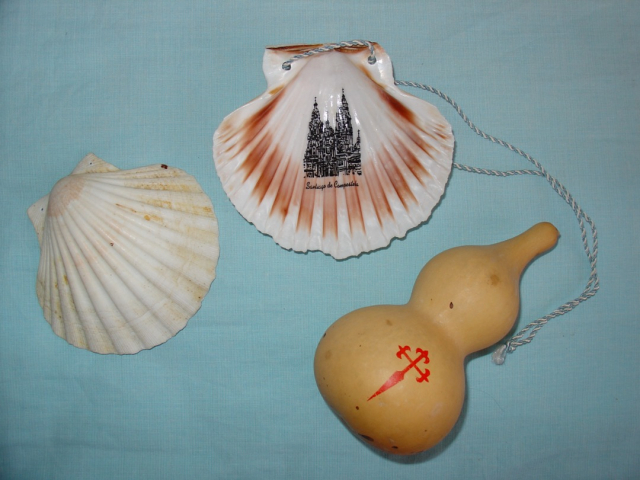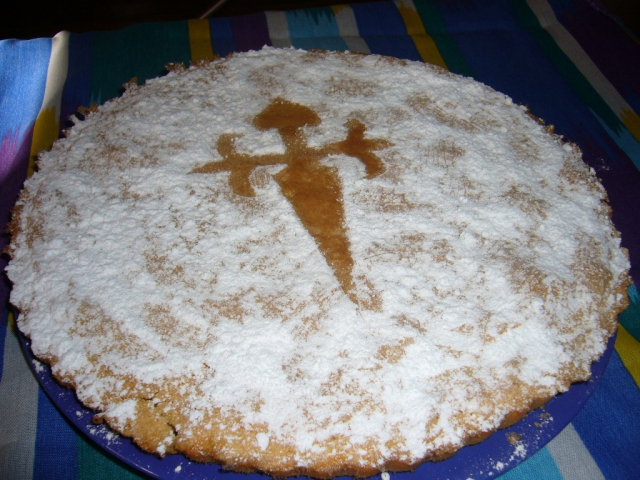The Cross of Santiago: Its origin and meaning
The Cross of Santiago is part of the most recognized symbols of the Camino de Santiago, which has a whole historical legacy related to the Jacobean culture
The Camino de Santiago is full of Jacobean symbols. Among the most important are the pilgrim's shell, the yellow arrows, the botafumeiro, etc. The Cross of Santiago is part of the symbols of the Camino de Santiago which has a historical legacy related to Jacobean culture.
The Cross of Santiago stands out for its cross and sword shape. Also for its striking red color, which symbolizes the blood shed by the Apostle James. From its origin, it has been linked to the Order of the Knights of Santiago, and today it is represented in numerous elements such as the coat of arms of the city of Compostela, to the typical Santiago cake.
What is the symbol of Apostle Santiago?
Although there are many symbols that we can relate to the Camino de Santiago, the symbol of the cross is the most linked to the Apostle Santiago. Known worldwide as the Cross of Santiago, it is a Latin cross with a shape very similar to a sword but with two finials at the top and a pommel on the hilt.
In addition to its characteristic shape, another of the most representative factors of this cross is its red color. It is said that this color was included in representation of the blood shed by the Apostle James due to his death by beheading by order of King Herod Agrippa in the year 44.
Origin of the Cross of Santiago
The Cross of Santiago had its origin with the founding of the Order of the Knights of Santiago in 1170, as it was its distinctive symbol. Its name comes from the Apostle James, the patron saint of Spain. The Order of Santiago had as objectives to protect the pilgrims along the Camino de Santiago and provide them with shelter, food, and spiritual help. In addition, they were also responsible for pushing back the Muslims in the peninsula while defending the Christian troops.
In 1175, Pope Alexander III approved the rules of the Order which included the adoption of the red cross as a symbol of identification of the Order of Santiago. Finally, the cross was introduced as a symbol in the form of a sword and an invocation of its vow to the Apostle James.
There are several theories about why the Order of Santiago adopted the red cross. One of them ensures that it is necessary to go back to the year 844, during the Battle of Clavijo. Legend has it that in this battle between Moors and Christians, the Apostle James appeared on a white horse carrying a white flag with a red cross and helped the Christians. Others seek the origin in the Crusades, where the knights carried small crosses with the bottom sharp to anchor them in the ground.
What does the Cross of Santiago mean?
As mentioned before, the Cross of Santiago is a very recognized symbol that has the shape of a cross and a sword and is bathed in a strong red color. In the arms and in the hilt, the lily flower is represented, a common symbol of the Middle Ages that alludes to the honor of the knights.
Just as there are several theories about why the red cross was adopted by the Order of Santiago, there are also theories about its meaning. The most widespread theory says that its double condition of cross and sword symbolizes on the one hand the defense of faith in Christ, and on the other hand, the use of weapons to defend the faith and the instrument used to decapitate the Apostle. As for the red color, there is no doubt that it represents the blood shed by the Apostle James during his martyrdom in Jerusalem. And also, the blood shed by the Christian army in defense of the faith.
Why did the Order of Santiago start using the cross?
Going back years, it is indicated that attention would have to be focused on the Battle of Clavijo in the year 844 to be able to trace its origin. Legend indicates that in this well-known battle fought between Moors and Christians the Apostle James appeared riding his white horse carrying a white flag with the red cross. All while interceding on behalf of the Christians.
However, there are others who point out that its origin is in the Crusades. At that time, the knights carried small crosses with the bottom sharp to, in this way, be able to nail them to the ground.
Whatever its origin, what is related is that the red cross was incorporated into other knightly orders related to the Camino de Santiago. Since then, members of the Chapter of the Cathedral of Santiago also wear it, becoming one of the most influential figures.
The Cross of Santiago today
Today we can find the Cross of Santiago in a wide variety of places. There is no doubt that it is a very typical element in Galicia and in other territories through which the Camino passes. We can also see it in many heraldic shields of Spain and even in cultural and sports associations, such as Celta de Vigo.
In another of the places where we can find this cross today is in the Santiago cake. This well-known dessert is adorned on the top with powdered sugar, except in the central part where the silhouette of the Cross of Santiago is usually drawn.
Where is the Cross of Santiago found?
Every pilgrim knows that the Cross of Santiago was one of the most important elements and, therefore, it has a great presence in tradition as well as historical events. In fact, it is not surprising to see many pilgrims wearing the cross as well as finding it along the way.
Proof of this is finding the Cross of Santiago in the painting of Las Meninas, which can be seen in the Prado Museum. In this painting, Diego Velázquez himself portrayed himself wearing the cross on his chest. However, it is said that, although he finished the painting in the year 1656, three years later he retouched it to add the cross, receiving there the distinction as a knight of the Order of Santiago.
Over the years, it has become one of the most representative symbols within the Camino de Santiago itself. In fact, it can be seen in signs for pilgrims, in establishments as well as in different souvenirs to commemorate the journey.
Routes
Blog
 How to get to Sarria to do the Camino de Santiago
How to get to Sarria to do the Camino de Santiago
 Descubre la magia del Camino de Santiago Portugués por la costa
Descubre la magia del Camino de Santiago Portugués por la costa
 5 tours culturales que puedes hacer en Galicia si decides hacer un alto en el camino
5 tours culturales que puedes hacer en Galicia si decides hacer un alto en el camino
 Doing the Camino de Santiago in June: What you should know?
Doing the Camino de Santiago in June: What you should know?
Information
Points of interest
Cities & Towns | Hostels | Lodgings | Restaurants | Saddlery | Doctors | Points of interest | Bikes workshop
Contact us | Privacy policy | Cookies policy | | Terms of use | Authorship | Web Map | Consentimiento
© Copyright LA VOZ DE GALICIA S.A. Polígono de Sabón, Arteixo, A CORUÑA (ESPAÑA) Inscrita en el Registro Mercantil de A Coruña en el Tomo 2438 del Archivo, Sección General, a los folios 91 y siguientes, hoja C-2141. CIF: A-15000649
Developed and managed byHyliacom


